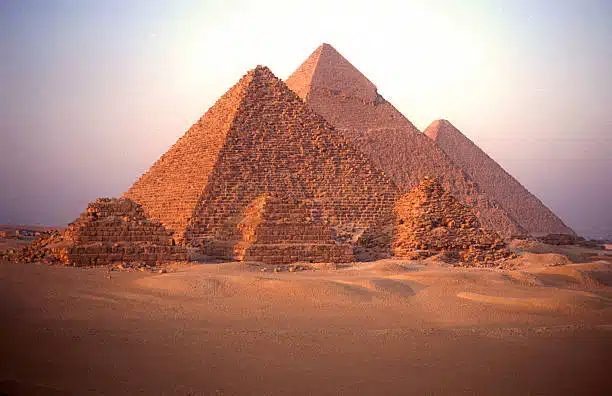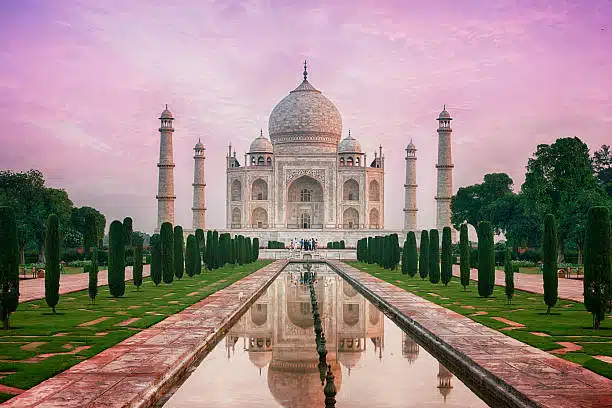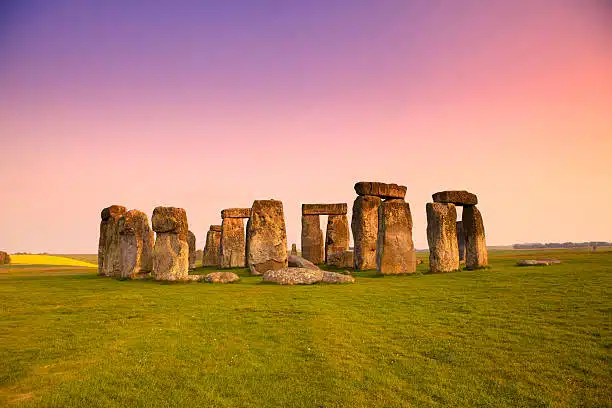What do the Great Pyramid of Giza, the Aberdeen Pavilion in Ottawa, Canada, the Taj Mahal, Stonehenge and the Statue of Liberty have in common? Aside from being iconic international landmarks that is.
If you hadn’t already guessed, then let us shed some light: granite has played a key role in the construction of each and every one of them.
In this blog, we’ll take a look at these historic monuments, delve into how granite was used in each application – and discuss the ways memorial makers, urban artists and landscape architects can use the tricks of the past to create stunning long-lasting landmarks today.
1. Embrace Durability like the Ancient Egyptians did
Granite is known for its strength and durability, making it the perfect choice for long-lasting structures. The largest of the three pyramids in Giza – a bona fide ancient wonder – is primarily constructed using limestone and granite blocks.
Memorial artists, urban designers and landscape artists can apply this same principle to their work today – by selecting durable materials, such as stone or concrete, for everything from foundations, paths, walls, to other decorative hardscape elements.
The results? Granite not only looks wonderful, it’s built to last. And by combining granite with other hard wearing stones, urban designers and artists will imbue their work with a sense of permanence and longevity – and minimize the need for constant maintenance.
2. Incorporate Texture and Contrast, a la The Taj Mahal
While primarily built using white marble, the Taj Mahal incorporates intricate inlay work featuring a variety of precious and semi-precious stones – and granite.
Granite often boasts unique textures and color variations, and today’s urban and memorial artists can take inspiration from this by incorporating different textures and contrasting elements into their sculptures and landscapes.
Combine smooth and rough surfaces, mix materials like wood and stone, or vary plant textures to create visual interest and dynamic compositions.
3. Balance Simplicity and Sophistication
Many granite architectural designs strike a balance between simplicity and sophistication. Today’s granite artists and landscape architects can apply this concept by creating clean lines and simple forms while incorporating elegant details and refined elements.
You can see this approach in the iconic The Aberdeen Pavilion (also known as the Horticulture Building) in Ottawa, Ontario, Canada. Constructed between 1898 and 1903, in the late Victorian and Edwardian architectural styles, it incorporates a striking combination of brick and stones including granite.
While the building’s foundation and lower levels were constructed using locally quarried Nepean sandstone – and the upper levels and exterior walls were made of red brick – granite is incorporated into the structure as accent pieces.
You’ll see granite in the columns, lintels, and many of the decorative elements of this forever-eye-catching building.
4. Prioritize Functionality
Granite architecture often focuses on functionality, ensuring that the stone serves a practical purpose.
One famous landmark that uses granite to service a functional *and* aesthetic purpose is the Statue of Liberty.
While its main body is made from copper – and its internal structures from steel and iron – the statue stands on a huge foundation of concrete, granite blocks and granite-faced concrete – all of which provide that all-important stability and support.
The Statue of Liberty’s pedestal is also made of granite. Its exterior comprises rough-hewn granite blocks, while its interior is constructed with dressed granite blocks. The rugged texture and natural colour variations of the granite contribute to the eternal visual (and very Instagrammable) appeal and impact of the structure.
5. Pay Attention to Scale and Proportion
From the most famous to the locally beloved, granite structures usually exhibit a sense of proportion and scale that fits harmoniously with their surroundings.
Granite architects, memorial artists and urban artists can apply this principle by carefully considering the scale of landscape elements, such as trees, shrubs, and architectural features. A truly, cohesive example of landscape architecture, art or memorial, needs to maintain a balance between the sizes of its different components and the world around it.
When considering landmarks that wow with their sense of scale and proportion, they don’t come much more iconic than Stonehenge – the ancient myth-enveloped, stone circle located in Wiltshire, England.
These prehistoric large standing stones – or, sarsens, as they’re better known – comprise many different types of stone and rock, including Preseli Spotted Dolerite, a type of igneous rock that contains a significant amount of granite.
Stonehenge is an imposing structure, with some of its stones weighing several tons and it stands at over 4m tall. The sheer hugeness and solidity of these stones create a grandeur and monumentality that has evoked awe and wonder in onlookers since its creation in the Neolithic period, around 2500 BC.
Conclusion
As we’ve explored, granite has played a key role in the structure of many of the most beloved landmarks around the world, including: the Taj Mahal, the Aberdeen Pavilion, the Statue of Liberty, Stonehenge and the Pyramid of Giza.
All of these landmarks showcase the enduring beauty and significance of granite in architecture and cultural heritage. Which is why landscape architects, memorial artists and urban designers love working with granite just as much today as they did then…
Contact us today
Did you know that we at HGH Granite have been providing granite services for the last 90 years? Our vision and business model have helped build a loyal customer base that relies on our expertise and quality workmanship. Over the years, our team has grown with like-minded individuals that share the same passion for providing outstanding granite products and services. Let us help build you your vision.




